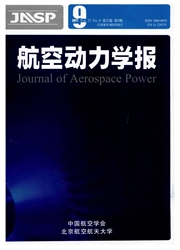

 中文摘要:
中文摘要:
针对红外系统实时跟踪捕获高速飞行弹箭目标的关键问题,提出了一种用于求解其全弹道动态红外辐射(IR)特性的方法.以典型155mm口径无控弹箭为研究对象,基于Simulink建立了模块化的6自由度(DOF)刚体弹道仿真模型,数值计算并分析了弹道诸元的变化规律.应用热网络法建立了弹体表面耦合换热动态热辐射场的物理模型,推导了弹箭高速旋转飞行的气动加热计算模型,并利用蒙特卡洛(M-C)法考虑了环境热辐射的影响.运用Runge-Kutta法耦合求解节点热平衡方程组,得到了动态气动表面传热系数、温度场以及红外辐射场的分布规律,对比分析了目标在整个飞行过程、不同部位、不同波段内的红外辐射特征.结果表明:目标发射后,其表面温度迅速升高,越靠近弹头部,温度升高速率越快,峰值温度越高;在飞行前20s内,其红外辐射特征明显;随着飞行速度衰减,热量散失较快,辐射强度较弱,且主要集中于8-14μm波段.
 英文摘要:
英文摘要:
In view of the key problems of the infrared system in tracking and acquisition of the high-speed flying projectile target in real-time, a method for solving the dynamic infrared radiation (IR) characteristics of the overall trajectory was proposed. Using 155 mm aperture uncontrolled projectile as the object, the 6-degree of freedom (DOF) rigid body ballistic simulation model was established based on Simulink, and the trajectory data were calculated and analyzed. With method by thermal network, a physical model of coupling heat transfer of dynamic IR field was built. The aerodynamic heating calculation model of highspeed rotatable flying projectile was deduced, and the effect of the environmental thermal radiation was considered by Monte-Carlo (M-C) method. The nodes thermal balance equations were solved using Runge-Kutta method, the distributions of dynamic aerodynamic heating transfer coefficient and temperature and IR fields were obtained, and then the flying projectile IR characteristics in whole fling process on the different positions and wave bands inter vals were analyzed. Results showed that the surface temperature increased rapidly when the projectile was launched in a short time. The more closer to the warhead means the faster the temperature rise rate, and the higher the peak temperature. The IR characteristics was obvious before 20 seconds in its flight trajectory. However, with the flight velocity decay resulted in rapid loss of heat, the radiation intensity weakened and mainly focused on 8-14μm wave bands.
 同期刊论文项目
同期刊论文项目
 同项目期刊论文
同项目期刊论文
 期刊信息
期刊信息
